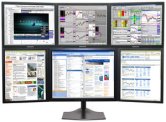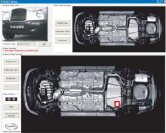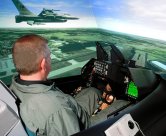

RESEARCH FROM THE INTERNATIONAL INFORMATICS
INSTITUTE
© 1995-2006 International
Informatics Institute, Inc. Some Rights Reserved.
This work is licensed under a
Creative Commons License.
Read our privacy guidelines.
Streaming media gained its early audience in the office, where fast T-1 lines and powerful PCs made those miserable early video feeds less poky. But once TV hit the office desktop, a wide range of business applications opened up that offered news, education, on-line meetings and surveillance applications at very affordable price points.
A Harris Interactive study for WebSense found that 80% of employees at U.S. companies with more than 100 employees have Internet access at work, with three-quarters of those having high speed connections. Employees average just under 9 hours per week on the Internet: 21% view streaming media; 10% play DVDs; 14% play games and 2% download media from peer-to-peer networks. Tens of millions of office workers are watching television at their desks, for business and for fun.
 Dell
Corp.'s new
customer support center in Ireland
prefigures the future of the
electronic office. I count about a dozen people and at least 60 video screens
in three-up configurations,
some running standard IT apps and others showing industrial video segments,
animations and live data visualizations. The introduction of 64-bit desktop
PCs with fast video screens and gigabit networks enables more visual
computing.
Dell
Corp.'s new
customer support center in Ireland
prefigures the future of the
electronic office. I count about a dozen people and at least 60 video screens
in three-up configurations,
some running standard IT apps and others showing industrial video segments,
animations and live data visualizations. The introduction of 64-bit desktop
PCs with fast video screens and gigabit networks enables more visual
computing.
 If
one video monitor is good, and three are better, then six are best. The
TigerVista
Arena monitors at left and
Horizon at
right come in many multi-screen
If
one video monitor is good, and three are better, then six are best. The
TigerVista
Arena monitors at left and
Horizon at
right come in many multi-screen configurations so you can work
a spreadsheet, surf the web, run a simulation and watch TV all at once. The
flat LCD monitors that have replaced bulky CRT screens combine large screen
forms with small desktop footprints.
configurations so you can work
a spreadsheet, surf the web, run a simulation and watch TV all at once. The
flat LCD monitors that have replaced bulky CRT screens combine large screen
forms with small desktop footprints.
 Low
cost webcams linked to conferencing software like this
WebEx demo at left record web seminars fo
Low
cost webcams linked to conferencing software like this
WebEx demo at left record web seminars fo r
distance learning over the Internet and video teleconferencing
for live meetings across multiple sites. Simplified authoring tools like
Serious Magic's Visual
Communicator at right streamline the process of producing and distributing
office videos on-line and on DVD.
r
distance learning over the Internet and video teleconferencing
for live meetings across multiple sites. Simplified authoring tools like
Serious Magic's Visual
Communicator at right streamline the process of producing and distributing
office videos on-line and on DVD.
 T
T he
Internet-connected webcams used for distance learning and teleconferencing are
also used in security and surveillance applications. The artificial
intelligence in
Stratech's car-bomb finder at left searches for unexpected anomalies with
before-and-after digital snapshots of suspect vehicles. The remarkable
iSee
Project plots the hundreds of webcams pointed at public spaces like the
New York Financial District.
he
Internet-connected webcams used for distance learning and teleconferencing are
also used in security and surveillance applications. The artificial
intelligence in
Stratech's car-bomb finder at left searches for unexpected anomalies with
before-and-after digital snapshots of suspect vehicles. The remarkable
iSee
Project plots the hundreds of webcams pointed at public spaces like the
New York Financial District.
 Another
kind of workplace is the cockpit of a jet fighter at 50,000 feet.
Another
kind of workplace is the cockpit of a jet fighter at 50,000 feet.
 The
Link simulation at left uses big wraparound video screens to train
pilots in complex maneuvers while they're safely
and more cheaply on the ground.
Google's Keyhole program
uses terrain maps and satellite imagery to let planners "fly" over proposed
terrain and virtually examine proposed building sites from the air.
The
Link simulation at left uses big wraparound video screens to train
pilots in complex maneuvers while they're safely
and more cheaply on the ground.
Google's Keyhole program
uses terrain maps and satellite imagery to let planners "fly" over proposed
terrain and virtually examine proposed building sites from the air.
3DGE Viral Video user-rated list of short Internet videos (not necessarily work safe)
Web@Work Survey by Harris Interactive for WebSense
American Sociery for Training and Development Learning Circuits e-learning case studies, news and stats
StreamingMedia.com Enterprise Video applications and products for Office TV
The Video Powered Enterprise vendor-sponsored white paper from SkyStream Networks
Employees may be surfing and downloading entertainment on company time, but business managers apply Office TV to lower costs, boost sales and increase productivity. IN3's Pervasive TV Project examines the opportunities for pin-striped video:
What is the effect on customer service, on marketing and branding, on overall corporate communications?
FREE
WEBCAST
IN3's research into the
development of video culminates
with our first Pay-Per-View webcast seminar.
Five Platforms examines all the places where video lives and paints
the big picture about television's future.
Learn more or ...
See the Driving Directions for a full list of features.
WATCH THE 90
SECOND TRAILER
ON YOUTUBE.COM